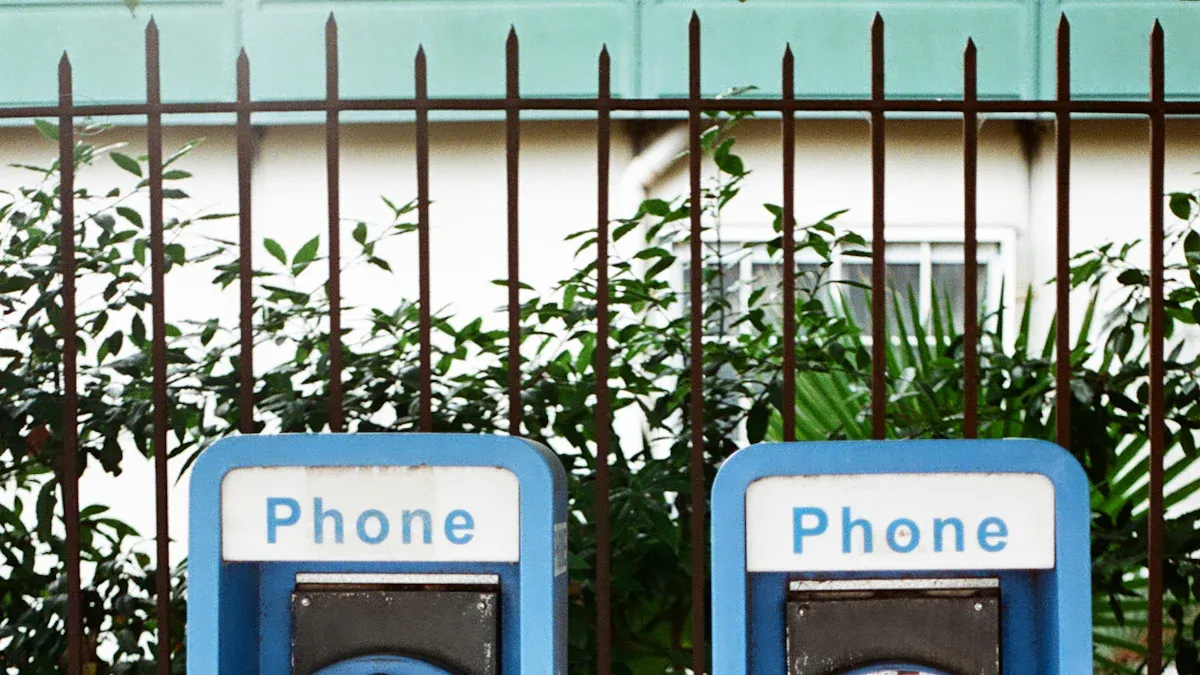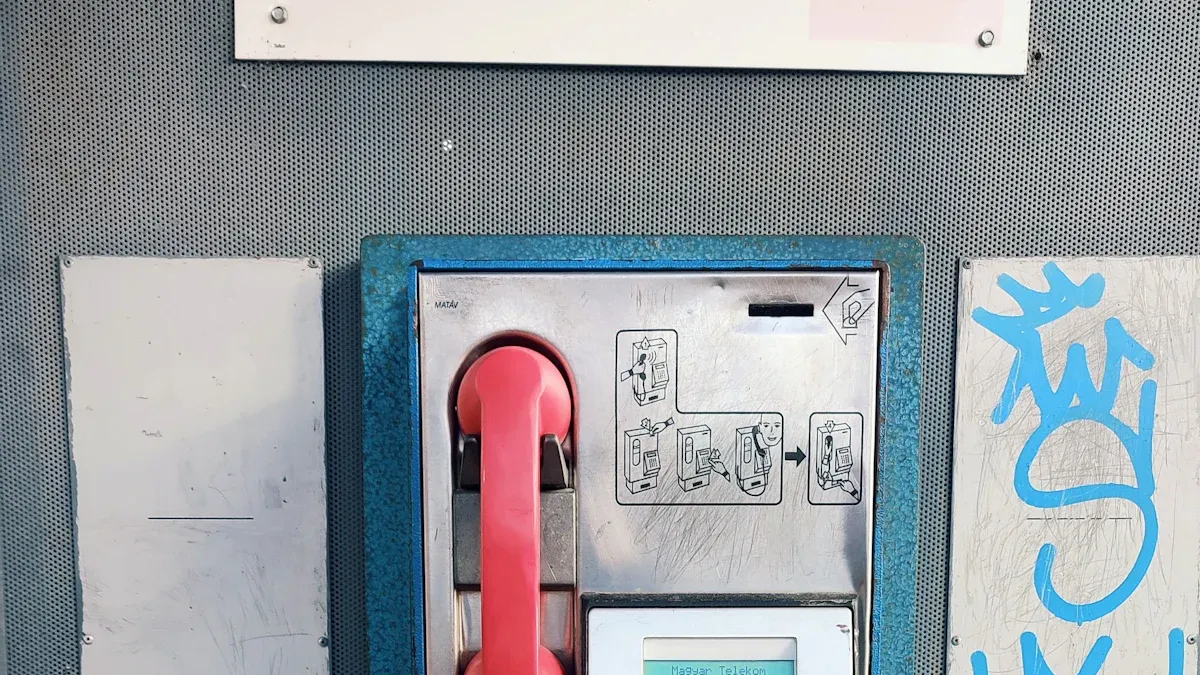
A public telephone handset is a robust device designed for communication in public spaces. You often find these handsets in areas requiring reliable and durable telecommunication tools. Devices like the fireman telephone handset assist in emergencies, while waterproof telephone handsets perform well in harsh environments. The telephone handset receiver transmits audio clearly, ensuring effective communication. Industrial telephone handsets also meet the demands of challenging workplaces, offering essential connectivity.
Key Takeaways
- Public phone handsets are made strong with tough materials. They use stainless steel and hard plastic to last long.
- Features like big buttons and Braille help all users. These make the phones easier for people with disabilities.
- New public phones use smart tech like VoIP for better calls. This keeps them useful in our modern digital world.
Key Features of a Public Telephone Handset

Durable Design and Materials
A public telephone handset is built to last. You will notice that these devices use high-quality materials like stainless steel, aluminum, or reinforced plastic. These materials resist wear and tear, making the handset suitable for outdoor and industrial environments. The design often includes weatherproofing, which protects the handset from rain, dust, and extreme temperatures.
For example, waterproof telephone handsets can function in heavy rain without any issues.
The handset’s cord is another durable component. It is typically made of armored steel or other tough materials to prevent damage. This ensures the device remains functional even in high-traffic areas or harsh conditions.
Accessibility and User Interface
Public telephone handsets are designed to be user-friendly. You will find that the buttons on the keypad are large and easy to press. This makes dialing simple, even for individuals with limited dexterity. Many handsets also include Braille markings to assist visually impaired users.
Some models feature amplified audio, which helps people with hearing difficulties. The handset’s ergonomic design ensures a comfortable grip, allowing users to hold it for extended periods without discomfort.
Tip: Look for handsets with adjustable volume controls if you need enhanced audio clarity.
Security and Anti-Vandalism Features
Security is a top priority for public telephone handsets. These devices often include anti-vandalism features to prevent tampering or theft. For instance, the handset’s casing is usually tamper-proof, and the cord is reinforced to withstand pulling or cutting.
Many models also come with secure mounting options. This ensures the handset stays firmly attached to its base, even in high-risk areas. Some advanced handsets include built-in alarms that activate if someone tries to remove or damage the device.
These features make public telephone handsets reliable tools for communication in public spaces.
Technical Specifications of a Public Telephone Handset
Build Quality and Materials
The build quality of a public telephone handset ensures it can handle tough conditions. Manufacturers use materials like stainless steel, reinforced plastic, or aluminum to make the handset strong and long-lasting. These materials resist corrosion, scratches, and impacts. You will notice that many handsets also include weatherproofing to protect them from rain, dust, and extreme temperatures.
The handset cord is another critical component. It is often made of armored steel or other durable materials. This design prevents damage from pulling or cutting, making the handset reliable in high-traffic areas or harsh environments.
Audio and Microphone Technology
The audio and microphone technology in a public telephone handset ensures clear communication. The handset includes a high-quality speaker that delivers crisp sound, even in noisy surroundings. You will find that the microphone is designed to pick up your voice accurately while reducing background noise.
Some models feature noise-canceling technology, which improves sound clarity. This is especially useful in busy public spaces or industrial settings. Amplified audio options are also available, helping users with hearing difficulties communicate effectively.
Keypad and Connectivity Options
The keypad on a public telephone handset is designed for ease of use. The buttons are large and easy to press, making dialing simple for everyone. Many keypads include Braille markings to assist visually impaired users.
In terms of connectivity, these handsets support various options. Some connect through traditional telephone lines, while others use modern technologies like VoIP (Voice over Internet Protocol). This flexibility allows the handset to work in different environments, from urban areas to remote locations.
Tip: Look for handsets with VoIP compatibility if you need advanced connectivity features.
How a Public Telephone Handset Works

Dialing and Signal Transmission
When you use a public telephone handset, the process begins with dialing. The keypad allows you to input the phone number you want to call. Each button press sends a signal to the internal system, which translates the number into a digital or analog signal. This signal travels through the connected network, whether it’s a traditional telephone line or a modern VoIP system.
The handset’s microphone captures your voice and converts it into electrical signals. These signals move through the network to the recipient’s device. At the same time, the speaker in the handset receives signals from the other end and converts them back into sound. This two-way transmission ensures clear communication.
Tip: If you’re in a noisy area, hold the handset close to your ear and mouth for better sound clarity.
Some advanced handsets use noise-canceling technology. This feature reduces background noise, making it easier for the person on the other end to hear you. The entire process happens almost instantly, allowing for real-time conversations.
Power Source and Energy Efficiency
Public telephone handsets rely on a power source to function. Many traditional models draw power directly from the telephone line. This setup eliminates the need for external batteries or charging. It also ensures the handset remains operational during power outages, which is crucial in emergencies.
Modern handsets, especially those using VoIP technology, may require an external power source. These devices often connect to a power outlet or use Power over Ethernet (PoE). PoE allows the handset to receive both power and data through a single cable, simplifying installation and reducing energy consumption.
Energy efficiency is a key consideration in the design of public telephone handsets. Manufacturers use low-power components to minimize energy use. Some models even include energy-saving features, such as automatic standby mode when the handset is not in use.
Note: Handsets with energy-efficient designs are better for the environment and can reduce operational costs.
By understanding how these devices work, you can appreciate their role in providing reliable communication in various settings.
Modern Relevance of Public Telephone Handsets
Emergency Use Cases
A public telephone handset plays a vital role during emergencies. You can rely on these devices when mobile networks fail or power outages occur. Many public handsets connect directly to emergency services, allowing you to call for help quickly. These devices often remain operational in extreme conditions, such as natural disasters or severe weather.
For example, you might find them in subway stations, airports, or remote areas where cell signals are weak. Their durability ensures they function even in challenging environments. Some models include features like direct-dial buttons for emergency numbers, saving valuable time when every second counts.
Tip: Always check for public telephones in your area. They can be lifesavers during unexpected situations.
Adaptations for Accessibility
Public telephone handsets are designed to serve everyone, including individuals with disabilities. You will notice features like Braille markings on keypads, which help visually impaired users. Amplified audio options make it easier for people with hearing difficulties to communicate.
Some handsets also include visual indicators, such as flashing lights, to signal incoming calls. These adaptations ensure that public telephones remain inclusive and accessible to all. By addressing diverse needs, they continue to provide reliable communication options in public spaces.
Integration with Modern Technology
Modern public telephone handsets have evolved to include advanced technology. Many now support VoIP, enabling calls over the internet. This feature improves call quality and reduces operational costs. Some handsets also offer USB ports for charging devices or Wi-Fi hotspots for internet access.
You might also find models with touchscreens, allowing you to browse directories or access additional services. These innovations ensure that public telephones stay relevant in today’s digital world. They bridge the gap between traditional communication and modern convenience.
Note: Look for public telephones with modern features when traveling. They can provide more than just a way to make calls.
A public telephone handset combines durability, accessibility, and advanced technology to provide reliable communication. Its robust design and clear audio ensure effective use in various environments. You can depend on these devices during emergencies or in areas with limited connectivity. Their integration with modern technology keeps them relevant in today’s world.
FAQ
What makes public telephone handsets different from regular phones?
Public telephone handsets are more durable. They resist vandalism, harsh weather, and heavy use. Their design includes features like reinforced cords and tamper-proof casings.
Can public telephone handsets work during power outages?
Yes, many handsets draw power directly from telephone lines. This ensures they remain operational even when electricity is unavailable, making them reliable during emergencies.
Are public telephone handsets accessible for people with disabilities?
Yes, they include features like Braille keypads, amplified audio, and visual indicators. These adaptations ensure everyone can use them effectively, regardless of physical limitations.
Tip: Look for handsets with adjustable volume or Braille markings for added accessibility.


